Need a plumber at 10 PM? Or an electrician with little notice? How about booking a trusted home service professional in the same way you book a cab — fast, easy, and right from your phone? That’s the beauty of handyman apps like Uber for services — they bring users together with experts there and then to make home services as easy as a few taps.
If you’re looking for a guide on how to create an app like this, then you’ve found the right place.
In this blog, we’ll cover everything you need to know about Handyman mobile app development. From essential features and budget estimates to the tech stack and monetization strategies that work. Whether you want to start small or go big, this guide is here to help you build a service platform that people will trust and return to.
8 Steps To Build A Handyman App
If you plan to create an app like Uber for a handyman, you need to be prepared with the right features and business model to make your app click in the competitive landscape. Whether it’s conducting market research or deploying your app, each step impacts your app’s success. Here’s a step-by-step guide:
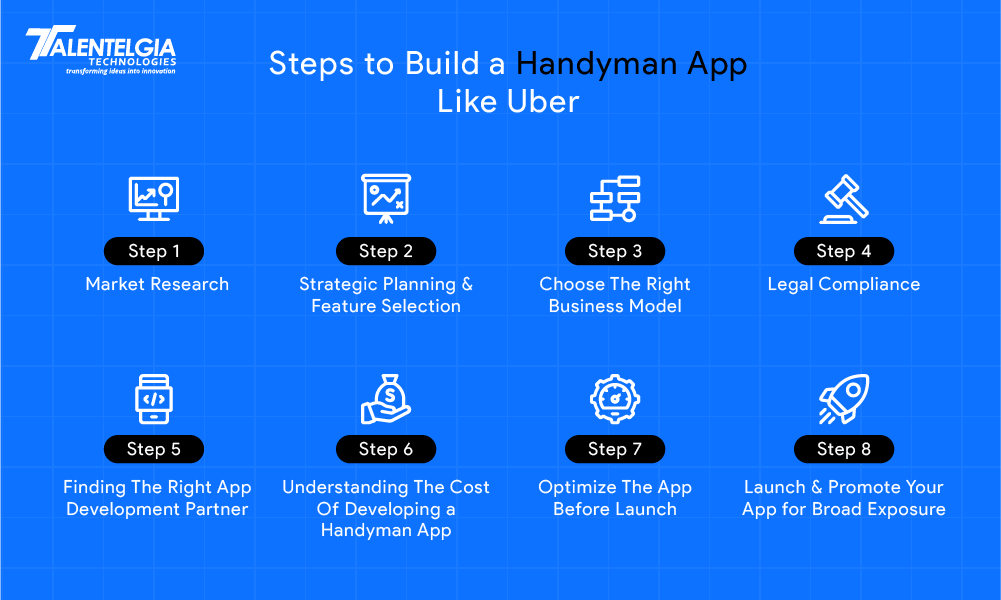
1. Market Research
The first step before starting the development of an Uber for handyman app is to research the market and establish a clear base for your business. This will help you uncover user needs, see what your competition is getting right (or wrong), and develop a solution that differentiates. Here’s how to approach it:
- What specific handyman services are most in demand in your target region (e.g., plumbing, electrical, furniture assembly)?
- Who are your biggest competitors, and what services do they offer?
- What are the common customer pain points with the current handyman service apps?
- Will your app cater to general home services or focus on a niche category?
- Does your audience prefer using mobile apps, web apps, or both?
2. Strategic Planning & Future Selection
Once you’ve validated your idea, the next step is to create a solid app strategy. This entails details on core functionalities, integrations (like ERP/CRM tools, social media, and payment gateways), and long-term sustainability.
Here’s what to look out for:
- Main Features: You need to create essential features like user registration, booking services, real-time tracking, in-app chat, reviews and ratings, technician profiles, and scheduling tools.
- Admin Section: Create an admin section where you can control the service providers, the users, the booked items, payments, and analytics from one place.
- Add Payment Gateway: Implement a safe and easy payment gateway such as Razorpay, Stripe, Google Pay, Apple Pay, or another that can facilitate easy transactions.
- Integrating Social Media: Enable users to register or sign in through Google, Facebook, or Apple for faster onboarding and referral sharing.
- Push Notifications: Schedule a notification trigger for users for their bookings, offers, status updates, or service reminders.
- Geo-location Services: Integrate GPS APIs for location tracking and assigning handymen nearest to service requests.
3. Choose The Right Business Model
The right business model to choose depends on your audience and how many services you intend to offer.
A. Single-Service Aggregator App
Suitable for budding companies to monopolise a niche market.
- Focused on a specific service category (plumbing, electrical repair, appliance servicing, car repair, home cleaning)
- Permits increased quality control as you are with a focused team.
This approach can be successful if you’re opening in a region with demand for a single key service or if you’re seeking to test the water with a more limited offering.
B. Multi-Service Aggregator App
Perfect for businesses targeting a wider audience with all-in-one home services.
- Offers multiple services under one app, such as electrical repairs, carpentry, HVAC maintenance, pest control, and more.
- Requires a larger pool of verified service providers with varied skill sets.
- Enables users to book different types of services from one platform, improving convenience and retention.
Regardless of whether you choose a single or multi-service model, the customer app and service provider panel must be inclusive of common features like:
- Simple registration and sign-in methods
- Predictive filters and searches for services
- Scheduling and booking systems
- Add tracking and updates in real time
4. Legal Compliance
Make sure to adhere to all local, state, and national regulations before you set out to launch your Uber-like handyman app. Having legal oversight not only protects your business but also builds trust with users and service providers. Here’s what to look out for:
- Employment & Labor Laws
Ensure that your service provider contracts comply with local labor laws. Are they freelancers, or are they employees? Keep roles clear to prevent misclassification problems.
- Regulations on Data Privacy Security
If your app collects personal information (like names, addresses, or payment info), you must comply with applicable data protection laws — like India’s Digital Personal Data Protection Act, GDPR (if you do business in Europe), or CCPA (in California).
- Business registration and taxation
This process involves legally registering your Handyman app business and making sure you’re good to go for local GST or VAT compliance. Familiarize procedure for service tax on different models of marketplaces.
5. Finding The Right App Development Partner
The success of your Handyman application depends on choosing the right app development partner. You want a team that not only shares your business goals but also has practical experience in developing on-demand platforms.
Key Questions to Consider when Evaluating a Mobile App Development Company:
1. Has it ever built an Uber-like on-demand service app before?
Look for Handyman, home service, or gig economy apps in their portfolio.
2. Can they develop a secure and scalable server-side architecture?
You need a platform that can handle real-time bookings, locations, and payments (and not crash under load).
3.Do they have easy-to-integrate APIs?
For example, third-party services such as Stripe, Razorpay (for payment gateways), third-party push notifications, CRM tools, and map APIs (like Google Maps).
A quality development partner will ensure the app runs smoothly and adheres to industry standards.
6. Understanding The Cost Of Developing a Handyman App
Budgeting is a key aspect of app development. The cost to build a handyman app can range from $15,000 to $60,000, depending on various factors .
Various Factors to Consider :
1. Which platforms are you targeting?
Will you build for iOS, Android, or go with a cross-platform solution?
2. What functionalities the Handyman app will have?
While the cost of basic features such as booking and payment is lower, the addition of advanced features like in-app chat, GPS tracking, and real-time updates adds to the costs.
3 . What’s your business model?
A single-service handyman app (like just plumbing or electrical work) is less expensive than a multi-service platform offering everything from cleaning to carpentry.
A well-planned budget ensures smooth development without unexpected financial constraints.
7. Optimize The App Before Launch
Test the app thoroughly before launch to fix any bugs and improve performance. Beta test with a niche group of users to get great feedback.
Some common testing phases are:
- Functional Testing:
Are all features—like booking, payments, and profile management—working exactly as intended? - Usability Testing:
Is the user interface intuitive? Can users easily navigate your app without confusion? - Performance Testing:
How well does the app perform under pressure? Check speed, responsiveness, and load handling during peak usage.
This ensures that the app works smoothly at a full launch, based on user feedback that informs improvements.
8. Launch & Promote Your App for Broad Exposure
After testing, publish your app on the App Store and Google Play Store (if needed).
The marketing strategy must be vigorous enough to pull users. Some examples of external promotional tactics:
- App Store Optimization (ASO): Keywords are the backbone of your app listing.
- Paid Social: Use paid ads on Facebook and Instagram.
- Referral Programs: Provide an incentive for users to bring in new members.
Post-launch budgeting will be essential to keep the app maintained and evolving according to user feedback. Your app will not fall behind the competition with continuous improvements.
Cost Of Developing A Handyman App Like Uber
Handyman app development cost is also decided based on the features, the platform selected, and where it will be developed. On average, a basic handyman app with all the essential features can cost anywhere from $50,000-$100,000, while an intermediate handyman app (with some AI-driven technology and AI integrations) can be above $250,000. The table below reflects a detailed cost breakdown:
Here’s a structured table summarizing the estimated costs of developing a Handyman app based on various factors:
| Factors | Cost Range |
|---|---|
| App Complexity | |
| – Simple App | $10,000 – $30,000 |
| – Intermediate App | $30,000 – $75,000 |
| – Complex App | $100,000+ |
| Platform Choice | |
| – Single Platform (iOS or Android) | $20,000 – $50,000 |
| – Cross-Platform (React Native/Flutter) | $30,000 – $80,000+ |
| – Progressive Web App (PWA) | $15,000 – $40,000 |
| Design & User Interface | |
| – Basic Design | $15,000 – $30,000 |
| – Custom Design | $30,000 – $60,000+ |
| – High-End Design | $60,000 – $100,000+ |
| Backend Infrastructure | |
| – Basic Backend | $10,000 – $25,000 |
| – Scalable Backend | $25,000 – $50,000+ |
| – Cloud-Based Backend | $15,000 – $40,000 |
| – Advanced Backend Services | $40,000 – $100,000+ |
| Third-Party Integrations | |
| – Payment Gateway | $2,000 – $5,000 |
| – Mapping & Location Services | $5,000 – $15,000 |
| – Social Media Integration | $1,000 – $3,000 |
| – External APIs | $5,000 – $20,000+ |
| – IoT Device Integration | $10,000 – $30,000+ |
| Development Team Location | |
| – North America/Western Europe | $100 – $250/hr |
| – Eastern Europe/Latin America | $30 – $80/hr |
| – Asia/Africa | $15 – $50/hr |
| Estimated Total Development Cost | $30,000 – $250,000+ |
Top Features To Include In Your Handyman App
A handyman app needs to provide a seamless user experience with convenience, safety, and efficiency. Given that the market is highly competitive, your app needs to focus on the few essential features that enhance both customer and service provider usability. Below are the top essentials that you should include:
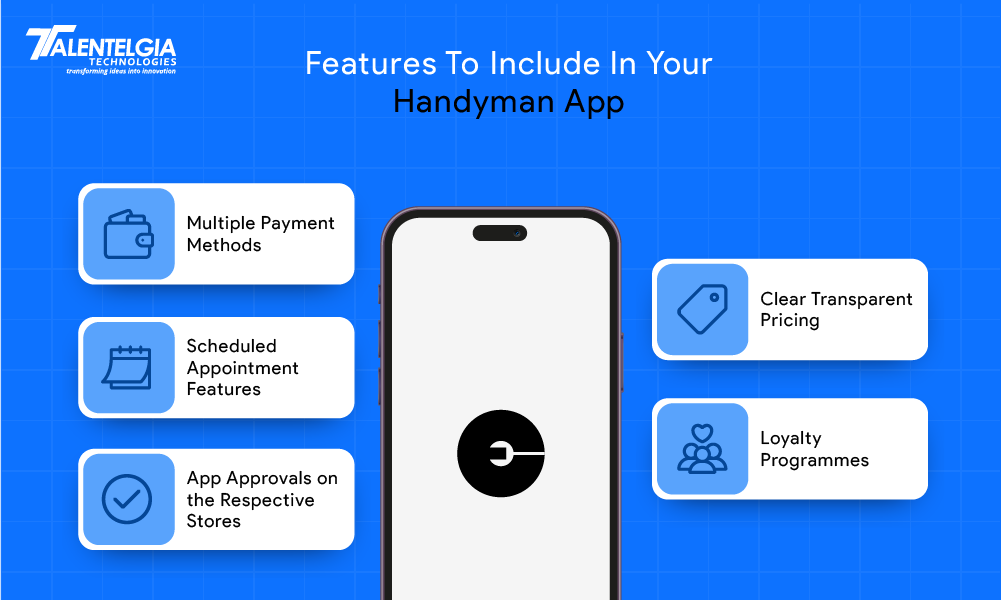
1. Multiple Payment Options
If you are building an Uber-type handyman app, then it is very important to enable multiple payment methods for a better user experience. Such a payment system should be flexible and secure so that users can pay easily, irrespective of their payment method. Depending on a single payment method can restrict your customers and affect the user experience.
To increase convenience, make it possible for users to pay by credit card, debit card, electronic wallet, and also UPI or internet banking. Make sure not to follow outdated techniques such as check payments, which can stall transactions. Using trusted payment gateways, such as Stripe, PayPal, or Razorpay, ensures data security while giving users a simple checkout experience. As long as you can offer a diverse and secure range of payment options, you will make your app more accessible, user-friendly, and market-competitive.
2. Scheduled Appointments
Handyman applications need flexible scheduling systems for users to book their services whenever they can. Some customers may require urgent repairs, while others might want to schedule their appointments in advance, according to their convenience.
Your application must have the provision of one-off bookings and future bookings so that no one is in any kind of trouble. Usability can be improved with features such as calendar integration, automated reminders, and real-time availability updates. This streamlines the booking process of customers, making it extremely convenient and also allowing the professionals to keep track of their clients efficiently.
3. App Approval On Respective Stores
A crucial step in launching your Handyman app is getting it approved on platforms such as the Google Play Store and Apple App Store. No matter the platform, there are rigid guidelines relating to security, user experience, and compliance, and not meeting these expectations can result in rejections and expanded timelines.
To avoid any delays in the approval process, the developers should adhere to certain best practices that include optimizing the app for its performance, ensuring a secure transaction, and complying with the data privacy policies of GDPR and CCPA, to name a few. Several handyman service apps, such as TaskRabbit or Handy & so on, handled these approval processes fluently by keeping user security intact while maintaining a perfect UI free from any malware and following the app store policies.
Thus, partnering with seasoned developers who have familiarity with these guidelines can expedite your app approval process, meaning you get to reach your end-users faster without delays in development.
4. Clear, Transparent Pricing
Pricing transparency is one of the main factors that affect user trust and user satisfaction. Clients don’t like surprise fees or unexpected charges when hiring someone to fix their stuff. Your app should include transparent and precise service cost breakdowns, estimates, and any relevant cancellation fees beforehand. This allows users to avoid unexpected charges and be able to choose consciously.
Thumbtack and Angi (formerly Angie’s List) are two apps that have successfully adopted transparent pricing models, where users can find estimated prices before signing up for a service. They also offer price comparisons based on the type of service and location for a broad overview of what customers can expect.
Offering detailed pricing breakdowns, cost calculators, and instant quotes within your app are features that can keep you competitive. This not only improves the experience but also helps you to gain long-term credibility.
5. Loyalty Programs
Having a proper loyalty program can work wonders for on-demand handyman apps, where users will keep coming back to use your app. Use Discounts, Reward Points, and Referral Programs: Discounts, reward points, and referral programs can also be employed to keep users engaged and drive them towards your app rather than a competitor’s.
TaskRabbit, for instance, occasionally comes through with markdowns for its repeat clients, while Handy has a membership plan that is subscription-based, giving users discounted service rates and exclusive benefits. Just like Uber and Lyft have effectively used rewards points and referral bonuses to drive customer loyalty.
To implement an effective loyalty program, consider:
- Discount Coupons for frequent users or those booking high-value services.
- Referral Bonuses that reward both the referrer and the new user.
- Subscription Plans offer perks like priority bookings and lower service charges.
- Push Notifications & Alerts inform users about limited-time deals.
A well-executed loyalty program not only boosts user retention but also increases customer lifetime value, ensuring that your app remains the go-to choice for handyman services.
Conclusion
Developing a handyman service app similar to Uber is not only a move towards the on-demand economy but also to providing significant value by means of convenience, trust, and reliability. From understanding the market gaps and deciding the ideal business model, to the inclusion of must-have features such as real-time booking, secure payments, and transparent pricing — everything plays a role in delivering a seamless experience for users and service providers.
By focusing on an effective roadmap development strategy and keeping the users coming back with loyalty programs and regular updates, you can manage to come up with an app that can survive this highly competitive environment. What, however, matters the most is that with the right app development company by your side, your idea will be transformed into a well-architected, scalable platform that users will love to use and come back to.
If you’re ready to hit the ground running and develop your own Uber-style handyman app, now is the time — demand is only going up, and there’s a wide-open market for innovation.
Frequently Asked Questions (FAQs)
Should I go for a single-service or multi-service model?
Single service is great for niche markets; multi-service is a broader target.
How do Handyman Apps Generate Revenue?
Through commissions, subscriptions, advertisements, and premium service provider listings.
What tech stack works best?
Use Flutter/React Native, Node. js backend, Firebase for the database, Google Maps API, and either Stripe or Razorpay.


 Healthcare App Development Services
Healthcare App Development Services
 Real Estate Web Development Services
Real Estate Web Development Services
 E-Commerce App Development Services
E-Commerce App Development Services E-Commerce Web Development Services
E-Commerce Web Development Services Blockchain E-commerce Development Company
Blockchain E-commerce Development Company
 Fintech App Development Services
Fintech App Development Services Fintech Web Development
Fintech Web Development Blockchain Fintech Development Company
Blockchain Fintech Development Company
 E-Learning App Development Services
E-Learning App Development Services
 Restaurant App Development Company
Restaurant App Development Company
 Mobile Game Development Company
Mobile Game Development Company
 Travel App Development Company
Travel App Development Company
 Automotive Web Design
Automotive Web Design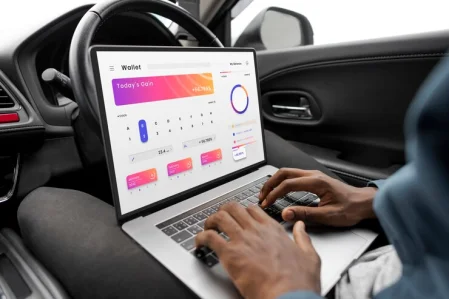
 AI Traffic Management System
AI Traffic Management System
 AI Inventory Management Software
AI Inventory Management Software
 AI Software Development
AI Software Development  AI Development Company
AI Development Company  AI App Development Services
AI App Development Services  ChatGPT integration services
ChatGPT integration services  AI Integration Services
AI Integration Services  Generative AI Development Services
Generative AI Development Services  Natural Language Processing Company
Natural Language Processing Company Machine Learning Development
Machine Learning Development  Machine learning consulting services
Machine learning consulting services  Blockchain Development
Blockchain Development  Blockchain Software Development
Blockchain Software Development  Smart Contract Development Company
Smart Contract Development Company  NFT Marketplace Development Services
NFT Marketplace Development Services  Asset Tokenization Company
Asset Tokenization Company DeFi Wallet Development Company
DeFi Wallet Development Company Mobile App Development
Mobile App Development  IOS App Development
IOS App Development  Android App Development
Android App Development  Cross-Platform App Development
Cross-Platform App Development  Augmented Reality (AR) App Development
Augmented Reality (AR) App Development  Virtual Reality (VR) App Development
Virtual Reality (VR) App Development  Web App Development
Web App Development  SaaS App Development
SaaS App Development Flutter
Flutter  React Native
React Native  Swift (IOS)
Swift (IOS)  Kotlin (Android)
Kotlin (Android)  Mean Stack Development
Mean Stack Development  AngularJS Development
AngularJS Development  MongoDB Development
MongoDB Development  Nodejs Development
Nodejs Development  Database Development
Database Development Ruby on Rails Development
Ruby on Rails Development Expressjs Development
Expressjs Development  Full Stack Development
Full Stack Development  Web Development Services
Web Development Services  Laravel Development
Laravel Development  LAMP Development
LAMP Development  Custom PHP Development
Custom PHP Development  .Net Development
.Net Development  User Experience Design Services
User Experience Design Services  User Interface Design Services
User Interface Design Services  Automated Testing
Automated Testing  Manual Testing
Manual Testing  Digital Marketing Services
Digital Marketing Services 
 Ride-Sharing And Taxi Services
Ride-Sharing And Taxi Services Food Delivery Services
Food Delivery Services Grocery Delivery Services
Grocery Delivery Services Transportation And Logistics
Transportation And Logistics Car Wash App
Car Wash App Home Services App
Home Services App ERP Development Services
ERP Development Services CMS Development Services
CMS Development Services LMS Development
LMS Development CRM Development
CRM Development DevOps Development Services
DevOps Development Services AI Business Solutions
AI Business Solutions AI Cloud Solutions
AI Cloud Solutions AI Chatbot Development
AI Chatbot Development API Development
API Development Blockchain Product Development
Blockchain Product Development Cryptocurrency Wallet Development
Cryptocurrency Wallet Development About Talentelgia
About Talentelgia  Our Team
Our Team  Our Culture
Our Culture 
 Healthcare App Development Services
Healthcare App Development Services Real Estate Web Development Services
Real Estate Web Development Services E-Commerce App Development Services
E-Commerce App Development Services E-Commerce Web Development Services
E-Commerce Web Development Services Blockchain E-commerce
Development Company
Blockchain E-commerce
Development Company Fintech App Development Services
Fintech App Development Services Finance Web Development
Finance Web Development Blockchain Fintech
Development Company
Blockchain Fintech
Development Company E-Learning App Development Services
E-Learning App Development Services Restaurant App Development Company
Restaurant App Development Company Mobile Game Development Company
Mobile Game Development Company Travel App Development Company
Travel App Development Company Automotive Web Design
Automotive Web Design AI Traffic Management System
AI Traffic Management System AI Inventory Management Software
AI Inventory Management Software AI Software Development
AI Software Development AI Development Company
AI Development Company ChatGPT integration services
ChatGPT integration services AI Integration Services
AI Integration Services Machine Learning Development
Machine Learning Development Machine learning consulting services
Machine learning consulting services Blockchain Development
Blockchain Development Blockchain Software Development
Blockchain Software Development Smart contract development company
Smart contract development company NFT marketplace development services
NFT marketplace development services IOS App Development
IOS App Development Android App Development
Android App Development Cross-Platform App Development
Cross-Platform App Development Augmented Reality (AR) App
Development
Augmented Reality (AR) App
Development Virtual Reality (VR) App Development
Virtual Reality (VR) App Development Web App Development
Web App Development Flutter
Flutter React
Native
React
Native Swift
(IOS)
Swift
(IOS) Kotlin (Android)
Kotlin (Android) MEAN Stack Development
MEAN Stack Development AngularJS Development
AngularJS Development MongoDB Development
MongoDB Development Nodejs Development
Nodejs Development Database development services
Database development services Ruby on Rails Development services
Ruby on Rails Development services Expressjs Development
Expressjs Development Full Stack Development
Full Stack Development Web Development Services
Web Development Services Laravel Development
Laravel Development LAMP
Development
LAMP
Development Custom PHP Development
Custom PHP Development User Experience Design Services
User Experience Design Services User Interface Design Services
User Interface Design Services Automated Testing
Automated Testing Manual
Testing
Manual
Testing About Talentelgia
About Talentelgia Our Team
Our Team Our Culture
Our Culture


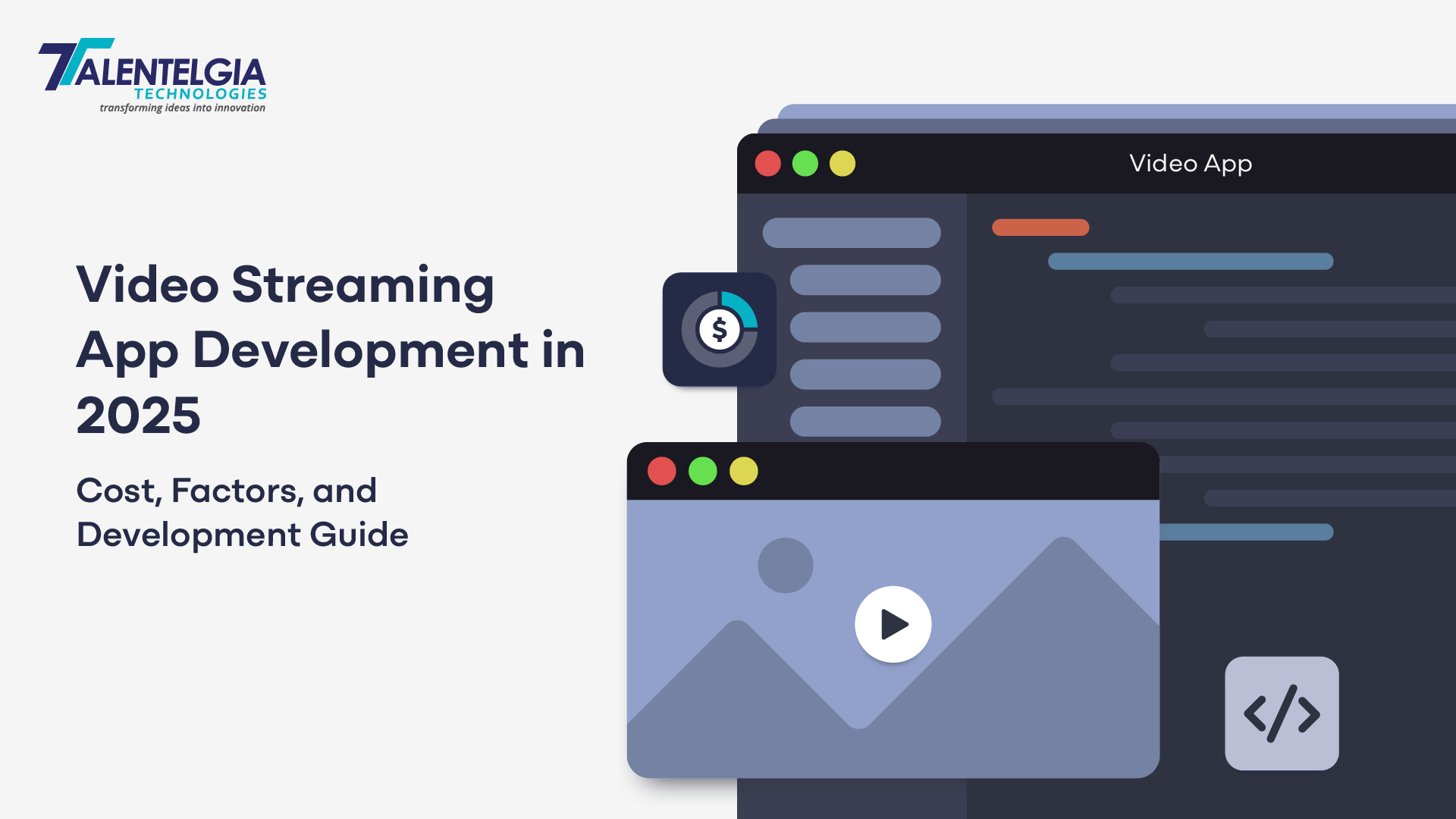


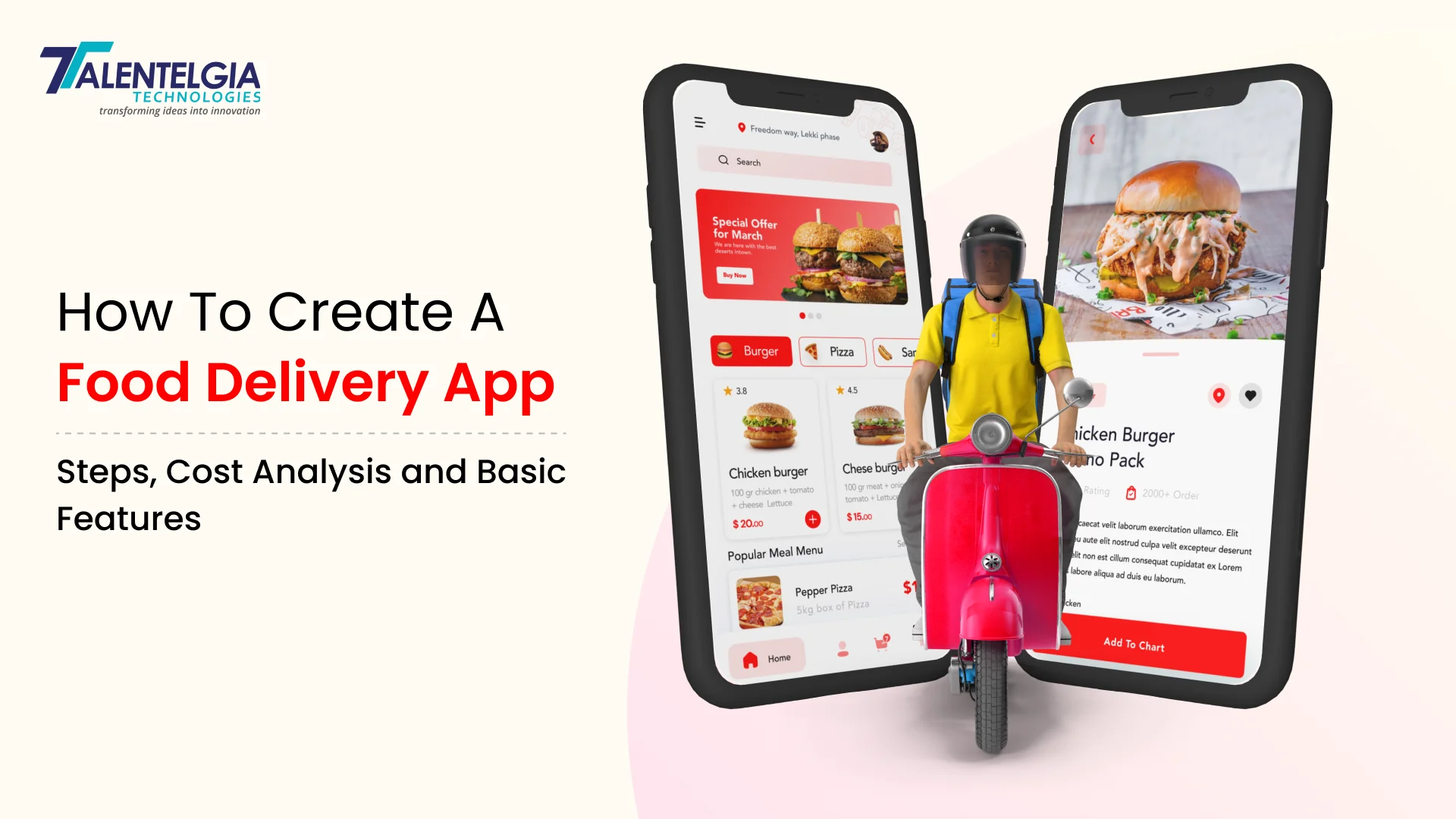











 Write us on:
Write us on:  Business queries:
Business queries:  HR:
HR: 




